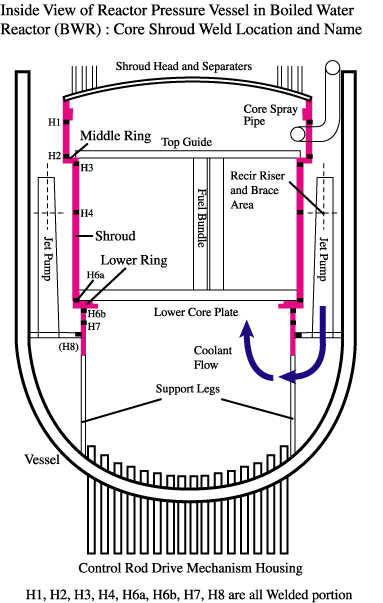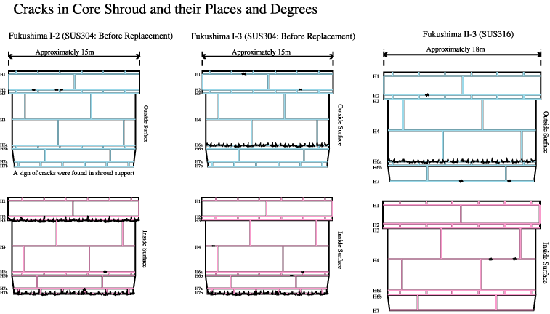Core Shroud Design Characteristics
The core shroud in a BWR is a huge stainless steel cylindrical component within the reactor pressure vessel (RPV) that surrounds the fuel assemblies. The core shroud acts as a separator of feedwater and plays an important role in supporting the fuel assemblies to maintain control rod insertion geometry.
As shown in figure 1’s cross-section of BWR reactor design, the core shroud is vertically welded to the RPV in which coolant flows induced downward on the surface of shroud, then upward through the fuel assemblies. The downward flow is the coolant returning back from the turbine. The water fraction is sent to the recirculation pump located outside of the reactor, which helps to feed water back to the RPV where the jet pump riser pipe and the jet pump converts high pressure into high velocity as the fluid goes through them, pushing the water toward the bottom of the vessel. Jet pumps are installed in the annular space between the core shroud and vessel wall where they are attached to the buffer plate.
The cross section of BWR core shroud (see Figure. 1) shows that there are two support ring structures (top guide support ring around H2 and H3 welded portion and core support ring around H6a and H6b welded portion). The fuel assemblies are held by the lower core plate on the lower ring and covered with the top guide on the middle ring. Being held by the upper and lower plates, the horizontal geometry of fuel assemblies are fixed and, therefore, the flow of cooling water is maintained.
| Figure 1. Inside view of reactor pressure vessel in Boiling Water Reactor (BWR); Core shroud weld location and name |
 |
What would happen if the core shroud collapsed?
Some of the cracks in the core shroud are depicted in Figure 2. The crack lines are drawn on the welded portion, however they are actually observed on the shroud body near the welded position. The core shroud is assembled to envelop the whole fuel assembly in the RPV. Therefore, in case of shroud collapse, it is reasonably possible to hypothesize the situation in which reactor control is not possible due to the loss or damage to the steam separators and steam dryers located on the shroud head.
| Figure 2. Cracks in core shroud at Fukushima I-2, I-3, and II-3 |
 |
The U.S. Nuclear Regulatory Commission (NRC) points out in their report that cracks that completely penetrated the shroud affect the flow of water coolant during regular operation, which could lead to a disruption of the coordination of power output and the water flow (NRC, 1996). Also, the NRC warned that significant problems concerning safety could be triggered when the shroud is demolished and separated due to the pipe rupture accident at the main steam pipe or recirculation pipe, which disrupt the function core spray system and control rod drive.
There have never been any safety inspections in Japan that analyze accident simulation assuming cracks in the core shroud. It is not always true that the safety inspection scenario could precisely predict the consequence of an accident resulting from a significant coolant loss accident such as the recirculation pipe rupture in a nuclear power plant with some cracks in its shroud.
According to the NRC report, the fuel rod assemblies in RPV would not be capable of circulating cooling water, because the coolant circulated in the shroud is leaked from cracks in the core shroud, which is also released from the recirculation pipe to the outside of the nuclear reactor. Even if the core shroud is in good condition, being capable of maintaining the circulation of cooling water, cracks in the shroud could ultimately lead to core meltdown, probably the most catastrophic accident that could occur at a nuclear power plant.
Reference:
U.S. Nuclear Regulatory Commission. 1996. “Status Report: Intergranular Stress Corrosion Cracking of BWR Core Shrouds and Other Internal Components.” Division of Engineering, Office of Nuclear Reactor Regulation. Washington, DC. NUREG-1544
Many press releases concerning the TEPCO scandal are available in English at the follwoing NISA’s homepage:
http://www.nisa.meti.go.jp/english/index.htm
Return to NIT 92 Contents

